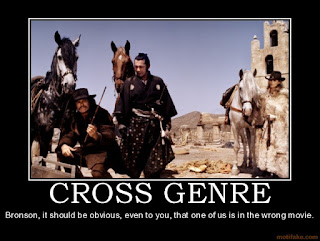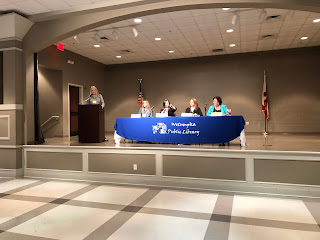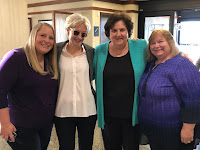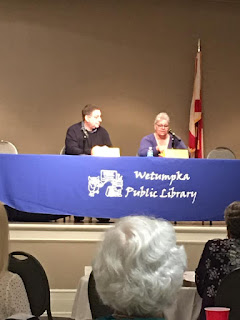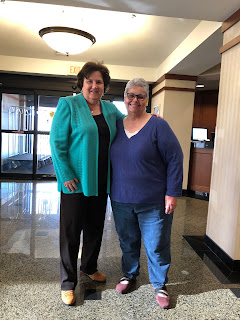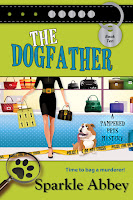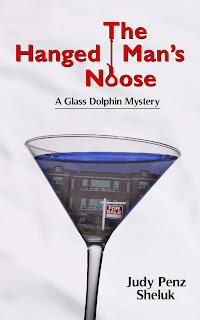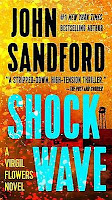by
Linda
Rodriguez
(This essay was just published in the anthology, Stranger in a Strange Land, which benefits the ACLU. Featuring
Walter Koenig, Linda Rodriguez, Patricia Abbott, Teresa Roman, R.C.
Barnes, James B. Nicola, Eric Beetner, Katherine
Tomlinson,
Heath Lowrance, Kimmy Dee, Mark Rogers, Sheikha A., Mark Hauer,
Berkeley Hunt, Manuel Royal, Kathleen Alcalá, Christine Mathewson,
Veronica Marie Lewis-Shaw, Zoe Chang, and James L’Etoile.
Wonderful
reading! Makes a terrific gift, as well. Check it out.
We’ve
Been Here All Along: 13
Ways of Looking at Latinos in the Midwest
1.
Here
in the middle of the country’s heart, I live surrounded by the
liquid names I love—Arredondo, Villalobos, Siquieros, Duarte,
Espinoza. We are a secret pool in the middle of this dry, often
drought-cursed Bible Belt, petitioners of La Virgen de Guadalupe and
Tonantzin with tall flickering novena candles set out on household
altars, devourers of caldo, horchata, albondigas with tongues that
roll “r”s and hiss our “z”s, dark faces, eyes, hair among all
these pale ones.
How
did we come to be here in a land covered in ice half the year? How
did we come to this place where no parrots fly free and flowers
freeze to death? Surely it was not our doing.
2.
Though
larger totals of Latinos were driven out of the border states during
the Depression’s forced deportations, the usually isolated
communities in the Midwest were hit the hardest—in some cases,
losing over half their population overnight. Those remaining kept
their heads down, hoping to avoid another violent outbreak. They made
their children speak only English.
Though
that had not mattered. Many of those shipped to Mexico were citizens
who spoke English fluently and little, if any, Spanish.
The
Midwestern communities became even more invisible. They just wanted
to be left alone.
3.
When
Federales chased Pancho Villa and his soldados over the countryside
in and out of the small farms and ranches and the dusty little towns
that supported them, each side of the conflict when it stopped for a
rest would force all the men and boys in a village or on a farm to
join its army. Worn out from the constant warfare of Mexico of that
time, those men and boys—and their families—wanted to be left in
peace. They fled to cities where men in suits from the north offered
them money if they would migrate to the land of gringos to work on
railroads or in meatpacking plants. The old streets-of-gold promise,
and it sounded much better than getting shot in one army or another.
Taking their families, they moved north to Chicago, Kansas City, and
Topeka.
4.
Ironically,
when the U.S. entered World War II and needed cannon fodder,
politicians remembered those English-speaking, American-citizen kids.
They sent military recruiters south. Large numbers of boys, driven by
force from their country to a land where they didn’t speak the
language and never fit in, signed up to go to Europe and the Pacific
to fight for the country they loved—even if it didn’t love them.
If
you didn’t read about this in your school history books, don’t be
surprised. Neither did I. This whole episode was like the internment
of American citizens of Japanese descent in camps during World War
II. After the paroxysm was over, we as a nation only wanted to forget
what we had done.
5.
The
oldest Latino community in Kansas City, Kansas, was built around an
entire village removed from Michoacan and settled into broken-down
boxcars beside the Kaw River. When I was younger, you could still see
the boxcar origins of houses in the Oakland community of Topeka,
Kansas, and the Argentine district in Kansas City, Kansas. Around the
core of boxcar, wood siding was added. New rooms and additions were
built over the years to make real homes.
Few
of these houses have survived the past four decades, but I still
remember them, always surrounded with luxuriant vegetable and flower
gardens in the tiny yard space around the houses—an emphatic
statement of a people who could indeed make silk purses out of sows’
ears or real two- or three-bedroom homes out of broken-down boxcars.
6.
In
2007, Kansas City, Missouri, had a new mayor. He had just appointed a
very active member of the local Minutemen organization to Kansas
City’s most powerful board. I
found the local Minutemen chapter’s website and read a call to go
door-to-door in Kansas City, demanding to see proof of citizenship or
legal status and making “citizen’s arrests” where the occupant
could not or would not show these. It was clear from the rhetoric on
the website that these would not be random visits but would target
homes with occupants who had Spanish last names.
I
took this threat personally. So when my friend Freda asked me to come
to an emergency press conference to show solidarity, I did. Leaders
of Chicano/Latino civic organizations formed the Kansas
City Latino Civil Rights Task Force to fight this appointment. We
were sure this would all end quickly. We were wrong, of course. It
took over six months of constant effort, national groups cancelling
conventions in the city, and the cooperation of African American,
Jewish, and Anglo groups. Along the way, something happened that I
have still to forget.
After
one meeting, my friend Tino of LULAC emailed me, “This is what the
Minutemen want.” Attached was a documentary video. The black and
white photos of Latino families being forced into crowded boxcars
reminded me powerfully of similar photos of Jewish families being
loaded onto trains in Nazi-occupied areas of Europe during the same
years.
7.
When
the Great Depression hit, citizens of Mexican ancestry made a great
scapegoat. Demagogues, sounding much like people we hear over the
airwaves today, blamed them and called for mass deportations. Groups
of armed vigilantes, most supported by local, state, and federal
government, beat and kidnapped men walking down the street to work or
home, visited homes with threats of violence and arrest, and drove
families out without any of their possessions. They forced huge
numbers of people without any of their belongings or food or water
into railroad boxcars where the doors were locked shut and the people
eventually dumped out in Mexico. The
elderly, babies and pregnant women, those already sick—physically
or mentally—suffered the most, and many died along the way.
Twenty-five children and adults died on just one of these trains on
its trip to the border.
8.
When
my children were small, I would take them with me to the Westside, to
Our Lady of Guadalupe Church, where the grandmothers sold fresh
tamales every Saturday to support the church. We would enter the cool
basement where las Guadalupeñas would coo at Crystal and Niles en
español. Crystal would respond by dancing around and laughing. Niles
would try to hide his face in my pant legs, clinging tightly and
crying until he pressed new creases. The old women would pack the
still-steaming tamales, wrapped by the dozens in foil, into a paper
bag and call out goodbyes to el niñito timido.
On
the way to the car, I would promise if he stopped crying we would
visit La Fama, the panadería, for Mexican bread. We picked out
thick, sugary cookie flags and pan dulce, carrying them all in a
paper bag that began to show grease spots from the sweet treats
inside before we got home.
Or
perhaps I would hold out the prospect of a visit to Sanchez Market
for chicharrones, the real thing, large, bubbled, almost transparent
from the deep-frying that made them so light and crunchy. While
there, I would stock up on peppers and spices that couldn’t be
found anywhere else in town as the kids relished their big chunks of
fried pork rind.
Back
then, we gathered around the church and food—at weddings, after
funerals, for quinceañeras, after First Communions, and at
fundraisers for American GI Forum, the organization founded by
decorated, returning Latino World War II veteranos when the American
Legion wouldn’t allow them to join.
Many
women had a specialty food—tamales, enchiladas, mole, tostadas,
arroz con pollo, sopa—that they were asked to bring. You always
wanted to go if they had Lupe’s mole or Jennie’s enchiladas. They
were better than you could get anywhere else unless you were lucky
enough to belong to Lupe’s or Jennie’s family. But these women
were generous and always shared with other families who were
celebrating or mourning or just raising money for beloved causes.
9.
Many
of those driven out in the 1930s were legal residents or citizens,
naturalized and native-born. Children born and raised in this country
were forced into a country they did not know with a language they did
not know and often compelled to leave behind the birth certificates
that proved their citizenship. Sixty percent of the 1.2 million
people driven out of the country were citizens. Many of these
families who were marched to the railroad cars and shipped out like
so much freight owned their own homes and even had small businesses.
All of this was forfeited to the mobs that kidnapped them and sent
them out of the U.S.
10.
I
listen for the broken truth that speaks of what’s been stolen,
what’s been cracked and smashed. Bit by bit, I try to put together
pieces, fragments of what was, stories for my children to live on. I
refuse the blindness and forgetfulness that would render me
acceptable in my country’s eyes, this country that lies about what
it did to its indigenous roots, about who provides the necessary
labor for all the luxury in which we live. Our comfortable lives are
built on bones, and how we long to forget!
11.
Herbert
Hoover never made a formal policy of forced deportation, but elements
within his government, along with state and local governments,
arranged for the railroad cars and gave approval to the vigilantes.
In some cases, it was actually government agents who drove people out
of their homes. At times, private institutions also financed
deportation boxcars. For example, the archdiocese of Kansas City,
Kansas, paid for boxcars to take families out of the city, many of
whom had lived there and worshipped as faithful Catholics since
before the turn of the century. In fact, in southern California,
hundreds of families were rounded up in 1931 as they attended
Catholic services on Ash Wednesday.
12.
In
Kansas City, Missouri, and Kansas City, Kansas, we have a large
Chicano population that has been in the area since the turn of the
twentieth century with third-generation and fourth-generation adult
U.S. citizens who speak primarily (and often only) English, have
college educations, and work as professionals. We also have a large,
newer population, deriving from Central and South America as much as
from Mexico, as often as not completely indigenous with little or no
Spanish, speaking Nahuatl, Quechua, Q’eqchi’.
I
have often thought the great public horror evinced about this new
wave of immigrants is due to their indigenous nature. The United
States can hardly bear to see such large numbers of indigenous people
as anything but threat when this country has worked so long and so
hard at wiping out its own indigenous peoples through violence,
disease, “education,” and the blood quantum rule the BIA has
imposed on our indigenous nations that still endure.
My
son Niles took a one-week European vacation. He flew home from London
by way of Detroit. In Detroit, this non-Spanish-speaking,
second-generation American citizen (on his father’s side), born and
raised in Kansas City, Missouri, was held for over 24 hours by
immigration authorities and refused entry into his own country, even
though he had a passport. They were certain he was an illegal
immigrant from Mexico trying to sneak into the U.S.
Neither
his valid documents nor his non-accented, perfectly colloquial
English could outweigh his brown skin and Spanish last name. He was
released and allowed to enter his own country only after his white
boss confirmed over the telephone that he was a citizen and had been
gainfully employed in a high-level professional position for seven
years.
To
me, this is doubly galling because Niles is not only Chicano but also Cherokee and Choctaw. My children and I have several lines
of ancestors who go back to the time before there was a United States
of America. I have always since wondered just exactly how many
illegal immigrants from Mexico named Niles have flown to England and
toured the Continent before trying to sneak into the U.S. on a flight
from London.
13.
People
always are surprised to find Latinos in Kansas City—anywhere in the
Midwest. We’re only supposed to congregate in Miami, New York, El
Paso, Phoenix, and LA.
Sometimes
I want to ask, “Who did you think picked all those fruits and
vegetables from the breadbasket of the country? Who worked in the
meatpacking hellholes, if not the Mexicans and Indians? Who kept the
trains cleaned, painted, and running, if not the African Americans
and Mexicans?”
Always
the invisible poor, laborers doing the work no one else wanted. Now,
it’s roofing and gardening, cleaning hotel rooms and offices at
night.
We’ve
been here a long time, long enough to lose our language sometimes,
while we were gaining diplomas and degrees, but never to lose our
culture completely. The newcomers make you nervous, afraid. But we’ve
been here all along—you just never noticed.

